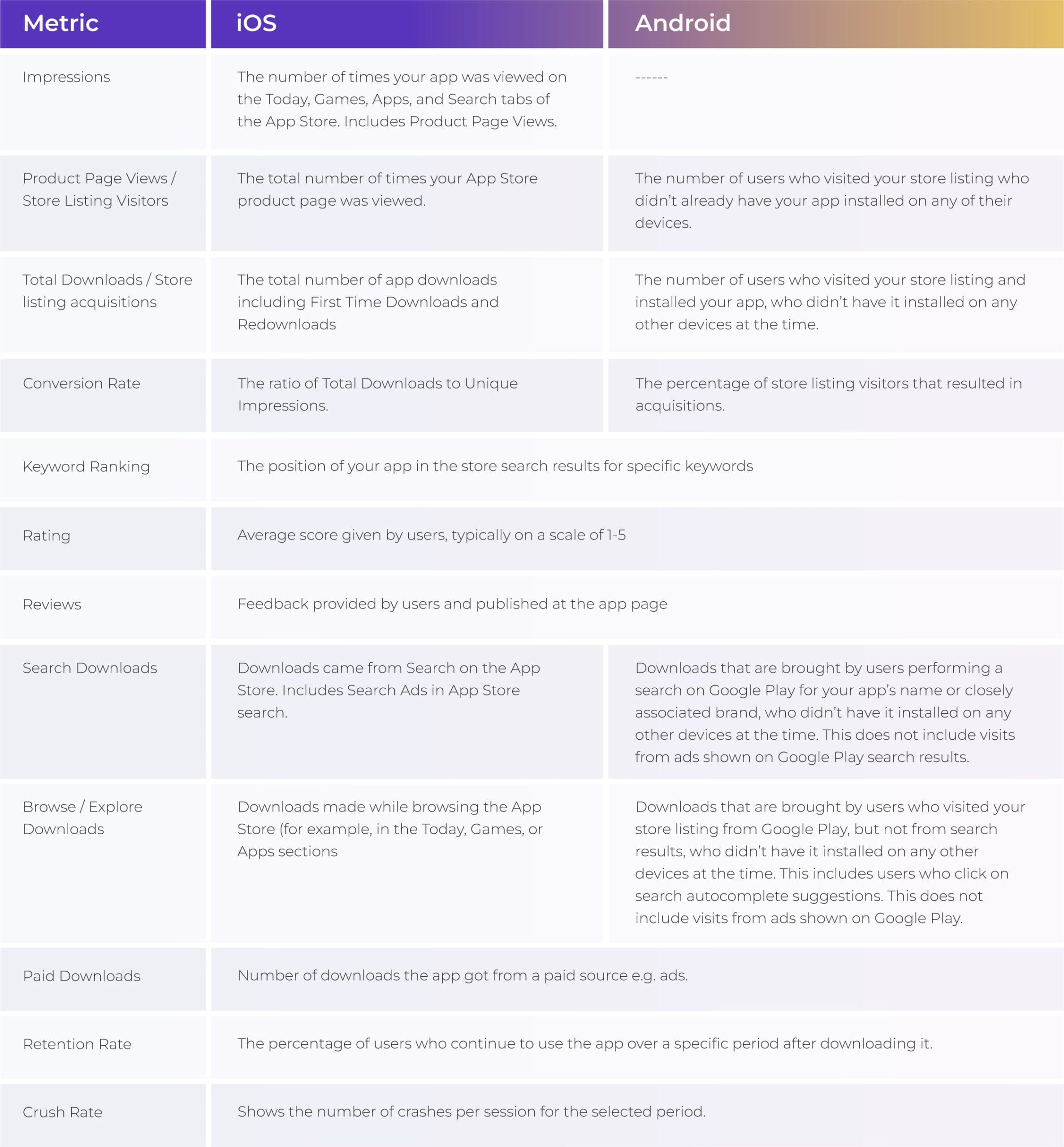An app’s success isn’t just about its ingenuity or usability. It hinges on how it’s marketed, perceived, and engaged with App Stores. App Store Optimization (ASO), the dark horse of app marketing, often determines the line between an app’s obscurity and prominence.
Table of Contents
While many developers prioritize the build and design of the app, the savviest of them understand that success post-launch revolves around ASO. But how can one measure the effectiveness of their ASO efforts? The answer lies in understanding and analyzing the right metrics and KPIs.
Understanding the Basics of ASO Metrics and KPIs
App Store Optimization (ASO) is more than just an initial setup; it’s a continuous endeavor. The app world is a bustling marketplace where every app is vying for attention. Here, ASO becomes the guiding light, ensuring your app doesn’t just blend into the crowd but stands tall, beckoning your target audience with its allure. The true battle goes beyond creating an innovative app. It’s about ensuring that amidst the sea of options, your creation catches the eye of those who truly matter.
But how do you know if your app is indeed making waves or merely floating adrift? Enter KPIs, the lifeblood of ASO. These metrics serve as tangible markers of your app’s journey. They don’t just reflect its visibility; they delve deeper, unveiling user satisfaction levels and areas of improvement. Every KPI paints a part of the bigger picture, helping refine and redefine ASO strategies.
However, in the dynamic mobile ecosystem, change is the only constant. User preferences shift, competitors up their game, and algorithms transform. It’s an ever-evolving dance, and the key to staying in rhythm is adopting an iterative approach. By monitoring and responding to these KPIs, one ensures that the app dances gracefully through the changing tides, always in tune with the ever-evolving beat.
Monitoring your ASO Performance: Crucial Metrics you need to know
1. App Visibility:
The journey of an app’s success begins with its visibility. If users can’t find your app, every other metric becomes redundant.
- Impressions: As Apple App Store guidelines say “A Unique Impression is counted when a customer views your app on the Today, Games, Apps, or Search tabs on the App Store, or on your product page.”. A surge in impressions signifies potential growth in the user base, but the true measure of success is turning these impressions into downloads.
- Store Listing Visitors (in Google Play Market) or Product Page Views (for Apple App Store): Platforms like Apple and Google offer insights into how many users land on your app’s listing. An increase in store listing visitors coupled with a stagnant download rate might indicate a need to revamp the app’s visual creatives or description.
- Downloads: The number of downloads is a necessary metric to be monitored but the trick hides in the breakdown by traffic source. Firstly downloads can be divided into two big groups: organic and paid, where the names reflect the origin of the installs. Secondly, organic downloads can be split up by search and explore/browse, which leads to various conversion rates of these two groups and can show different user behavior.
- Keyword Rankings: Keywords are the gateways through which potential users find your app. A strategic approach to keyword optimization can place your app in front of the right audience, amplifying both impressions and downloads.
2. Conversion Rate:
It’s pivotal to understand that not every visitor to your app’s page will end up downloading it. But what’s an acceptable conversion rate? This varies, but optimizing this metric can have exponential effects on your user base.
- Conversion Rate Measurement: Apple and Google have different approaches to defining conversions. Understanding these nuances allows for a more tailored optimization strategy.
- Strategies for enhancement: Stellar visuals, crisp descriptions, and spotlighting unique app features can propel conversions. Moreover, actively addressing user feedback can build trust, encouraging fence-sitters to make the plunge.
3. Rating and Reviews:
User feedback, encapsulated in ratings and reviews, can make or break an app. A pristine 5-star rating can propel downloads, while a slew of negative reviews can dampen even the most aggressive marketing efforts.
- The Domino Effect: Reviews and ratings directly influence an app’s store ranking. Higher rankings amplify visibility, and more relevant downloads bring more ratings and reviews, creating a virtuous cycle of increased downloads and visibility.
- Users trust: App rating is one of the crucial factors that influence the decision either to download the app or not. Featured reviews can help customers to make a decision. In this case, negative reviews with no answer can ruin the conversion rate.
- Acting on Feedback: Negative reviews, while disheartening, are gold mines of feedback. Addressing these promptly and iterating on the feedback can transform disgruntled users into brand ambassadors.
4. Organic vs. Paid Installs:
While tracking downloads is straightforward, discerning between organic and paid installs offers deeper insights.
- Organic Installs: These users can exhibit higher engagement and retention, as they’ve discovered the app while looking for exactly this app or something like this.
- Paid Installs: While paid campaigns can boost numbers, it’s crucial to balance the ratio. Over-reliance on paid installs can mask deficiencies in ASO, leading to inflated acquisition costs.
5. Downloads Velocity
This is usually not the metric that is spoken about, as much as the number of downloads but still remains a very important factor that influences the app’s ranking in an app store. The higher the velocity per keyword is, the higher the app goes in ranking per this keyword, which allows it to get more impressions, downloads and potentially more revenue.
6. Revenue
Though it can be challenging to estimate the revenue volume brought by organic downloads only, revenue is still a vital metric that should be monitored by ASO managers. One can increase the total number of impressions, and downloads but would still have no revenue growth because of targeting “non-paying users” or low-revenue markets. But here the question arises: does it correspond with your business goals?
A table you can save: Here’s our key ASO Metrics with Definitions

App Store Optimization, at its core, is about being seen and chosen. While it might be tempting to simply focus on downloads, the real game lies in understanding the metrics behind those downloads. A clear grasp of these metrics provides insights into user preferences, behavior, and expectations. Additionally, these metrics allow businesses to fine-tune their marketing strategies, ensuring a higher return on investment (ROI) and a more significant growth potential for the app.
Enhancing your ASO with Tools:
Navigating the vast landscape of App Store Optimization (ASO) without guidance can feel like sailing the high seas without a map. But with the right set of ASO tools, the journey becomes less about trial and error and more about strategic manoeuvres. These ASO tools are akin to the modern-day compasses of the digital realm, pointing app developers and marketers in the right direction, ensuring every move is calculated and every decision data-driven.
Keyword Optimization is a quintessential pillar of ASO for app launch or a small app at the beginning of its journey. Think of keywords as the beacons that guide users to your app amidst a crowded sea of alternatives. Tools play a pivotal role here. They don’t merely help identify these beacons; they ensure you’re leveraging the most impactful ones. By aiding in the discovery of high-impact keywords, they enable you to elevate your app’s visibility without proportionately increasing your marketing expenditures. It’s about working smarter, not harder, ensuring that every dollar spent yields maximum visibility dividends.
Using ASO tools to spy on your competitors
Then there’s the arena of positioning among competitors. In the app world, understanding your standing isn’t just about pride; it’s about strategy. With a vast amount of apps vying for the same user attention, knowing where you fit in the competitive spectrum is invaluable. It’s not about mimicking the top performers but understanding them. By grasping how your app measures against its competitors, you can uncover unique areas of differentiation, turning perceived weaknesses into strengths and spotlighting areas ripe for improvement.
Optimizing your visual assets
Lastly, the aspect of visual optimization deserves special mention. In a world that’s increasingly visual-first, the importance of an app’s aesthetics cannot be understated. But it’s not just about creating stunning visuals; it’s about understanding their impact. Through tools that facilitate A/B testing of visuals and descriptions, marketers get insights into user preferences. By experimenting with different visual elements and narratives, one can fine-tune the presentation, leading to tangible improvements in conversion rates. It’s about merging creativity with data, ensuring that your app’s first impression is not just memorable, but also persuasive.
Conclusion on ASO Metrics for app success:
An app’s success is an intricate ballet of development, design, effective ASO and listening to users’ feedback. By diving deep into ASO metrics and KPIs, developers and marketers can craft strategies that not only elevate visibility but ensure sustained success in the ever-evolving mobile ecosystem.
If you are looking for guidance on how to improve the results of your marketing efforts involving ASO in your marketing strategy, get in touch with us, our ASO experts can help you through.



